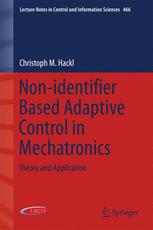

Most ebook files are in PDF format, so you can easily read them using various software such as Foxit Reader or directly on the Google Chrome browser.
Some ebook files are released by publishers in other formats such as .awz, .mobi, .epub, .fb2, etc. You may need to install specific software to read these formats on mobile/PC, such as Calibre.
Please read the tutorial at this link: https://ebookbell.com/faq
We offer FREE conversion to the popular formats you request; however, this may take some time. Therefore, right after payment, please email us, and we will try to provide the service as quickly as possible.
For some exceptional file formats or broken links (if any), please refrain from opening any disputes. Instead, email us first, and we will try to assist within a maximum of 6 hours.
EbookBell Team

5.0
60 reviewsThis book introduces non-identifier-based adaptive control (with and without internal model) and its application to the current, speed and position control of mechatronic systems such as electrical synchronous machines, wind turbine systems, industrial servo systems, and rigid-link, revolute-joint robots.
In mechatronics, there is often only rough knowledge of the system. Due to parameter uncertainties, nonlinearities and unknown disturbances, model-based control strategies can reach their performance or stability limits without iterative controller design and performance evaluation, or system identification and parameter estimation. The non-identifier-based adaptive control presented is an alternative that neither identifies the system nor estimates its parameters but ensures stability. The adaptive controllers are easy to implement, compensate for disturbances and are inherently robust to parameter uncertainties and nonlinearities. For controller implementation only structural system knowledge (like relative degree, input-to-state stable zero dynamics and known sign of the high-frequency gain) is required. Moreover, the presented controllers guarantee reference tracking with prescribed asymptotic or transient accuracy, i.e. the tracking error eventually tends to or for all time evolves within an a priori specified region.
The book presents the theory, modeling and application in a general but detailed and self-contained manner, making it easy to read and understand, particularly for newcomers to the topics covered